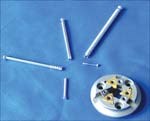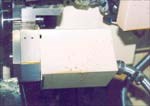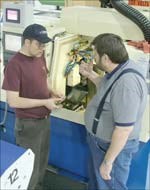Boning Up On Thread Whirling's Advantages
Thread whirling attachments installed on this bone screw maker's Swiss screw machines prove to be just the right prescription for the company's mix of screw sizes and run quantities.
Nothing beats the satisfaction that comes with having the right tool for the job. When Pioneer Surgical Technology (Marquette, Michigan), a manufacturer of orthopedic implants and instrumentation, expanded its product line to include cannulated (tubular) bone screws, threading the screws presented a number of problems. After reviewing its threading options, the firm decided that thread whirling offered the best method for its mix of screw sizes and lot sizes.
Pioneer was founded in 1992 by Dr. Matthew N. Songer, a practicing orthopedic surgeon in the Marquette area. The firm's first product was the Songer Spinal Cable System, developed as an alternative to monofilament wire for spinal fixation procedures to correct damage from trauma and/or degenerative diseases such as scoliosis. From there, the firm's product line grew to include other bone-repair implants and the surgical tools used to install them. Many of the products resulted from orthopedic surgeons' ideas for better tools for reconstructive work.
Pioneer's machining department started with a milling machine and a manual lathe about 13 years ago. It quickly graduated to CNC machine tools such as horizontal and vertical machining centers, CNC lathes and wire EDM machines and eventually standardized on Swiss screw machines as its main production machines. The Swiss screw machines were chosen for their ability to produce complex round parts complete in one setup.
Another reason for choosing the Swiss machines—Pioneer has 12—is their flexibility. "We are a relatively small company," explains Matt Hanfelt, manufacturing engineer for the company. "Where a large company would have a separate prototype department, we do our production and prototype work on the same machines."
Pioneer makes its cannulated screws from stainless steel and titanium in diameters from 3 millimeters to 9 millimeters and in lengths from about 5 millimeters to several hundred millimeters. The firm distributes the screws to hospital operating rooms in kits consisting of five each of 30 different screw lengths (150 screws in all), and replaces each screw as it is used.
Two Production Modes
Accordingly, Pioneer's screw production falls into two categories: a production mode where the firm introduces a new line of screws and produces them in quantity for assembly into kits and a reorder mode where screws are made in very small quantities to replace screws used in the kits. Machines shift from one mode to the other to provide the quantities required for the new product introductions.
"The new product roll-outs account for 70 to 80 percent of total production," explains Mr. Hanfelt. "Introduction of a new product can tie up 40 to 50 percent of our production capacity. During such a period, we may set up a machine to run a family of 3-millimeter in diameter screws where the only feature that changes is screw length. The job may run for weeks, using the same tools and bar size. Except for replacement of worn tools, the only changes are programming changes for the different screw lengths.
"As production requirements for each new product roll-out are met, production settles back to the replacement mode," Mr. Hanfelt continues. "On a typical day, 80 to 90 percent of the screws being produced in the shop are replacement screws. The runs can involve quantities as small as one, so frequent change-overs are the rule."
When Pioneer began production of its bone screw line, it single-point threaded the screws. That created a number of problems. "The first problem was the length," Mr. Hanfelt explains. "Some of our screws are just less than 9 inches long, which meant unsupported threading over long lengths on some of our older production machines.
"Cycle time was also a problem," he adds. "We had learned how to single-point the threads, but the process was slow. Also, we had a problem with a slot in the screw. When we milled the slot before the threading operation, the interrupted cut would result in frequent insert breakage. If we milled the slot after the threading operation, we would get burrs in the threads."
Looking for a more efficient alternative to single-point threading the bone screws, Pioneer considered threading the screws on a stand-alone thread whirling machine. But that route offered its own set of problems. The first issue was that Pioneer would have to buy a much larger (and more expensive) machine than it wanted in order to accommodate the longer screw lengths. Second, the machine constituted a secondary operation, which ran counter to the company's policy of avoiding secondary operations where possible.
There was also a materials usage issue with the stand-alone thread whirling machine. Additional length was needed on each end of the screw to hold it firmly during the thread whirling operation. Afterward, the shop would have to remove the extra material in still another secondary operation. Finally, once the extra material was removed, additional operations would be required to drill and broach a self-tapping head at each end of the screw.
Finally, the stand-alone thread whirling machines that Pioneer looked at required fairly complicated setups that needed a considerable amount of downtime. It was thought that the stand-alone machine would require too much downtime to change from one screw length to another in the production mode, and using it to produce reorder parts in small quantities just didn't make sense.
By this time, the company had converted to Swiss screw machines for most or all of its primary production machines, so it asked the machine tool builder if there was a way for it to do thread whirling on the Swiss machines. The machine tool manufacturer was very receptive to Pioneer's request, particularly since thread whirling devices were starting to show up on competitive machine tools.
Homemade Inserts
In a short amount of time, the builder developed a compact thread whirling attachment for Pioneer's machines. The builder was unable to locate inserts for the attachments however, and asked its customer to provide them. Pioneer was also unable to locate inserts for the attachment and decided to make them in-house. It shipped the homemade inserts to Japan and then followed up with a visit to witness a trial run. Pioneer was so pleased with the results that it ultimately purchased a thread whirling attachment for all but two of its machines.
While the homemade inserts served to prove out the thread whirling attachment, the high hourly cost of making them ruled out their use on a continuing basis. They were not only more expensive than inserts produced by the grinding process, but they also wore quickly.
Pioneer wanted to get out of the insert-making business. Besides, it couldn't afford to tie up its product machines making inserts. Therefore, it approached several of the major insert producers for help. "It was very frustrating trying to communicate our needs for the thread whirling insert to the tooling companies," Mr. Hanfelt remembers. "We sent drawings, we sent models, we explained what we wanted, but we did not seem to be able to get anyone to understand what we needed. Most of the tooling companies that we talked to were seemingly not interested in our problem.
"However, George Butz, the Sandvik Coromant representative in our area, took an interest in our project," Mr. Hanfelt continues. "He called on us frequently, and we had quite a few discussions about what we were trying to accomplish and why things were designed the way they were on the insert. He became familiar enough with the application that he was able to communicate our needs to his production people in terms they would understand."
Largely as a result of Mr. Butz's perseverance, Pioneer placed an order for inserts with his company. Quality issues arose almost immediately, beginning with Pioneer's tolerance requirements for the insert. The process that it had used to produce the inserts in-house is very precise, so the company was able to hold very tight tolerances on corner radii. However, the cutting tools manufacturer's insert-grinding equipment had not been designed with those tolerances in mind. If Pioneer hoped to lower its tooling costs, it would have to relax the tolerance requirements for the ground inserts.
Because the two companies used different inspection methodologies, efforts had to be made to equalize the insert measurements. To resolve that issue, Mike Nixon, Sandvik's grind shop manager, visited Pioneer, went through the entire thread whirling operation with Pioneer's personnel and spent time checking his plant's ground inserts on Pioneer's vision-based inspection system. When he returned to Houston, Mr. Nixon purchased the same vision-based inspection system Pioneer uses, which eliminated the measurement differences.
They Understand Our Needs
"As a result of that close collaboration, we are confident that its grinding facility understands our product and our insert needs," Mr. Hanfelt notes. "Another consideration is that they have taken steps to shorten delivery time on our insert orders. To make a custom insert, you take a standard grade insert and grind it to the required profile. That means that the customer must wait for the standard insert to be made and then ground. Sandvik Coromant keeps a quantity of standard inserts at its grinding plant, ready and waiting to be ground for us. That puts us 3 to 4 weeks ahead of standard delivery time for our inserts."
Assessing The Gains
One of the insert maker's more important contributions was the expertise it provided in selecting the right insert grade and coating for Pioneer's applications. "The stainless steel that we use for our bone screws is extremely tough," Mr. Hanfelt explains. "It work hardens and chews up our inserts. The insert grade that it recommended provided a tremendous increase in productivity compared to those we had been making in-house. I can't tell you the number of parts we're getting per cutting edge, but we are getting two to four times as many parts per edge with the new inserts as we were getting with our own inserts.
"The inserts have also increased our production rate," he continues. "In the first place, we are not changing inserts as frequently, so our machines are running more often. Second, changing worn inserts on the thread whirling attachment is a relatively fast procedure. The operator can either remove the entire head from the thread whirling attachment or leave the head in place and replace the inserts individually.
"Most of our operators keep a spare head at the machine and simply swap heads to minimize downtime. That's the most efficient method, since it avoids idling the machine for the amount of time it takes the operator to index or replace the (three) inserts. The machine is back into production quickly, and the operator can index or replace the inserts on the head that was removed while the machine is making parts."
Because the inserts last longer, Mr. Hanfelt adds that most jobs can be run on a single set of inserts. Operators don't have to worry about changing inserts in mid-run, and the possibility of variations in the bone screws resulting from slight differences from one cutting edge to the next is eliminated.
How important is thread whirling to Pioneer? "The thread whirling process enables us to make bone screws in lengths and diameters that we could not make any other way on our existing machines," Mr. Hanfelt stresses. "Achieving thread whirling capability on our Swiss screw machines with an attachment significantly reduced our cost of acquiring that capability compared to having to buy dedicated thread whirling equipment. We did not have to make room for an additional machine or two and, best of all, we were able to avoid thread whirling as a secondary operation altogether. We can make the part complete on our Swiss machines. It's fair to say that, without our thread whirling capability, we probably would not be in the bone screw business today."
Related Content
Parting Off: The Case for Standardizing on Sawing
The value of rotary saw cutting for parting off operations could boil down to simple economics paired with process efficiency gains.
Read MoreBoring Head Enables Sculpture Hardware to Be Machined on a Lathe
When small job shop Ansonia Manufacturing took on a tricky hardware component job for a “live” glass art sculpture, it realized a boring head would be needed to machine the part complete on its live-tool lathe.
Read MoreReplaceable-Insert Spade Drill Basics, Advantages
Although solid carbide and indexable-insert drills have their place in a machine shop, replaceable-insert spade drills offer specific advantages for various holemaking operations on machining centers and lathes.
Read MoreMaking Micro Threads
Production of micro threads can be challenging, but using the most suitable tools for a given application can simplify the task.
Read MoreRead Next
Do You Have Single Points of Failure?
Plans need to be in place before a catastrophic event occurs.
Read MoreEmerging Leaders Nominations Now Open
Here’s your chance to highlight a young person in your manufacturing business who is on the path to be a future leader moving your company forward.
Read MoreA Tooling Workshop Worth a Visit
Marubeni Citizen-Cincom’s tooling and accessory workshop offers a chance to learn more about ancillary devices that can boost machining efficiency and capability.
Read More











.jpg;maxWidth=300;quality=90)












